Space Power is about the generation of power from space.
The space around Earth is filled with intense sunlight, undiffused by atmosphere, continuously. It represents an inexhausible supply of energy that can be converted to electricity using semiconductors - that is without the use of any moving parts.
A small fraction of this energy could supply a large part of the world's future energy requirements for the foreseeable future. In addition, it could do it without the need for any kind of fuel, and without producing any waste product.
All that's needed is large-area collectors - and that means large, thousands of square kilometers - and a way to transmit the collected power down to Earth. Several different methods are possible, but the one that has received the most effort so far is the use of microwave beams or wireless power transmission.- 29 July 2012
- Added "Space Debris and Its Mitigation
" to the archive.
- 16 July 2012
- Space Future has been on something of a hiatus of late. With the concept of Space Tourism steadily increasing in acceptance, and the advances of commercial space, much of our purpose could be said to be achieved. But this industry is still nascent, and there's much to do. So...watch this space.
- 9 December 2010
- Updated "What the Growth of a Space Tourism Industry Could Contribute to Employment, Economic Growth, Environmental Protection, Education, Culture and World Peace
" to the 2009 revision.
- 7 December 2008
- "What the Growth of a Space Tourism Industry Could Contribute to Employment, Economic Growth, Environmental Protection, Education, Culture and World Peace
" is now the top entry on Space Future's Key Documents list.
- 30 November 2008
- Added Lynx
to the Vehicle Designs page.
To receive announcements and news of updates by email, subscribe to the sf-announce mailing list.
Join the sf-discuss mailing list to ask questions and talk about space tourism, vehicles, power, and habitats.
More Info- Space-based Solar Power by 2016?
- When Stephen Hawking Speaks...
- Space-Based Solar Power, the PowerSat Way
- Space Frontier Foundation Submits SSP Whitepaper
- The 40th Anniversary of the Solar Power Satellite
- Mini-Documentaries on Space
- Why Space Solar Power Is Superior to Biomass Fuel
- Department of Defense Feasibility Study
- Space Solar Power Blog
- Global Warming...
- How Much Do You Know About Space
- Space Future Editor Wins NewSpace Journalism Award
- China's First Manned Docking of Space Module Is a Success
- Five Horrifying Facts
- NASA Will Pay You to Eat Astronaut Food
- Attention Teachers: If You Don't Apply to This Workshop
- Space Is Dirty
- The Film That NASA Banned
- SRI holds Inaugural Conference
- Zubrin's Proposal to Fund "Pathway to the Stars"
Here are some key documents from the archive to get you started:
- What the Growth of a Space Tourism Industry Could Contribute to Employment, Economic Growth, Environmental Protection, Education, Culture and World Peace
- Space Tourism Market Demand and the Transportation Infrastructure
- General Public Space Travel and Tourism
- Artificial Gravity and the Architecture of Orbital Habitats
- Prospects of Space Tourism
More Documents
|
| |
|
| |
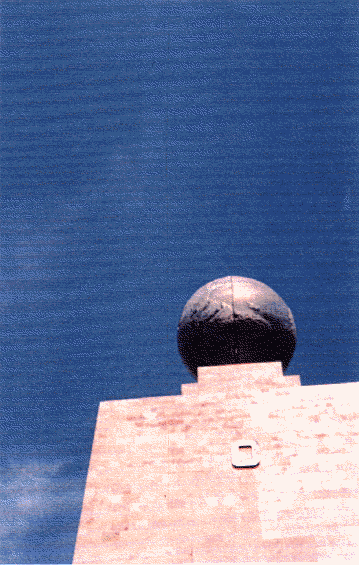
Looking up towards equatorial orbit above the 'Mitad del Mundo' monument in Ecuador.
Welcome to this Issue
In this 3rd issue we report on our fifth equatorial field visit, to Ecuador this October, where there is a possibility of siting a rectenna at high altitude in the Andes. For a new energy system like SPS, safety is of fundamental importance. A major aspect of SPS safety is the safety of microwaves, which depends above all on their biological effects. We also propose a new category of collaboration for 'near-equatorial' countries which are too far from the equator for an SPS 2000 rectenna, but which can participate in SPS 2000 in other ways such as performing experiments on the microwave power beam.
Biological effects of microwaves
'Microwaves' are electromagnetic waves covering the range between infra-red and short-wave radio-waves, having frequencies from about 100 Tera-Hertz to about 10 Mega-Hertz - that is, wavelengths from about 1 micron to about 100 meters. In telecommunications they are used for mobile telephones, television, satellite communication, radar and other uses. Microwaves also have a heating effect on materials which absorb them, and so they are used in cooking, in medicine and in manufacturing. The effects of microwaves on biological systems (plants, animals, cells, and biological molecules) depend on their frequency and on their intensity (or 'power density') which is measured most simply as power per umt area, eg Watts/square meter (W/sqm). Microwave intensity is also measured using the comparative decibel units (dB) which define power density with respect to a standard level, and are particularly convenient for the very low power density levels at which communication systems operate. An important factor to note when considering any particular case is whether the microwaves are 'pulsed' or 'continuous wave' (CW). For example, radars use pulsed microwaves - such as a 1 microsecond pulse of 50 kW/sqm intensity every 50 microseconds. In this case the average power density would be 1 kW/sqm, but the physical reality and the biological effects would be different from CW radiation of this intensity. The main physical effect of microwaves is to excite electrons. When an electron absorbs a microwave photon its vibration energy and so its temperature increases. Consequently one possible environmental impact of SPS could be for the microwave beam to excite the electrons in the ionosphere at it passes through - but such an effect depends on the beam intensity, as we will discuss in a later issue. 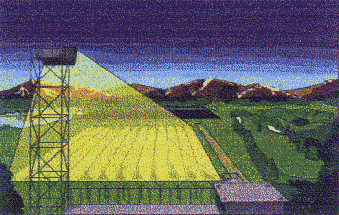
'Microwave Country' proposal for a long-term exposure experiment over several years
The energy of a photon depends on the frequency, as described by Planck's constant, h, (E = h f). Microwave photons have lower frequencies than all other forms of electromagnetic radiation except radio waves, and so they have low energy. They are known as 'non-ionizing' radiation, since the energy in one photon of microwave energy is not sufficient to remove an electron from most molecules - ie to 'ionize' them. This is very different from 'gamma rays', 'X rays', other types of nuclear radiation and even ultra-violet and visible light. These forms of radiation all have higher frequencies and so higher photon energies than microwaves, and they can excite an electron enough to leave the molecule or atom which absorbs it, which may alter its chemical properties. In the case of a molecule in a biological system this may have harmful effects, such as damaging a protein, or in an extreme case altering the behaviour of a cell nucleus so that it grows continuously - becoming 'cancerous'. However, non-ionizing radiation cannot do this, and simply causes heating of the atom or molecule which absorbs it. SPS 2000 will use CW microwaves at 2.45 GHz (ie 12.5 cm) as used in microwave ovens. For this kind of radiation the international safety standard for the general public is 10 W/sqm. Note that this is about 1% of the intensity of sunlight at the equator, and has a very weak heating effect. (By comparison, a human body typically produces 50-100 W of heat, which it radiates as infra-red energy.) There has been some controversy about this standard, because some Soviet research seemed to show 'non-heating' effects at much lower intensities - but western scientists have been unable to replicate the results. Some critics have claimed that the microwave industry is hiding the evidence. However, there have been thousands of papers published on this subject, many by scientists completely independent of the microwave industry, and there is no known physical mechanism for such effects. Furthermore, there are now some 50 million microwave ovens in use around the world, and no case of harm caused by them - which is statistically very good evidence that this standard is safe! Nevertheless more research is needed to be certain that SPS will be safe - such as the 'Microwave Country' proposal (see picture above). Two points should be remembered about microwave safety: microwave radiation can be concentrated by conductors such as metal objects, creating 'hot-spots' several times higher than the average intensity. Second, the most sensitive part of the body is the front of the eye. This is because it does not have a blood supply, and so cannot cool itself actively as other parts of the body do. Eyes are easily protected by safety glasses with a conducting layer across the front which absorbs microwave energy - so please be careful. Finally, we must remember that telecommunications systems are much more sensitive than biological systems, and interference can be caused by much lower microwave intensities - see later issue.
Field Research Around the Equator (5)
In 1994 the Japanese Ministry of Education, Science and Culture awarded a grant for SPS 2000 field research in a number of equatorial countries in order to study the siting of rectennas there. The objectives of this research are to make contact with colleagues in these countries; to have initial discussions with government representatives; to identify candidate rectenna sites; to develop some preliminary ideas about appropriate rectenna designs for each site; and to consider how each rectenna might best be utilised. Professor Hideo Matsuoka and Dr Patrick Collins made the 5th field visit in this series to Ecuador from October 3rd to October 10. Initially they visited the offices of the Foundation for Science & Technology (FUNDACYT) in the capital Quito, Due to the recent change in the government following a general election, administrative responsibility for energy and tele-communications were not yet finally allocated. However, staff of FUNDACYT were very interested in the possibility of Ecuador participating in the SPS 2000 project, and undertook to have discussions with these ministries with which they have close links. 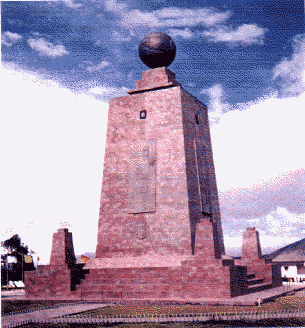
The 'Mitad del Mundo' monument north of Quito commemorating the discoveiy of the equator. It's interesting that the line marking the equator is red: the Japanese word for equator (sekidoh) means 'red road'.
FUNDACYT is innovative in that most of its funding is raised from outside the country, and it takes a very business-like approach to science and technology policy. It was suggested that if a rectenna was built in Ecuador, it might be best to establish it as a corporation. This has a number of advantages, as discussed below. Professor Matsuoka and Dr Collins also met staff from the Department for Meteorology, Hydrology and Planning (INAMHI) which, among other responsibilities, records climatic data as is needed to design the rectenna structure. They also had a discussion with staff from Saint Francis University who are interested in collaborating in preliminary research on candidate rectenna sites in Ecuador. They then travelled via the second city of Guayaquil to San Cristobal island in the Galapagos archipelago, some 1000 kilometers west of the Ecuador mainland. The SPS 2000 satellite will deliver power to each rectenna for up to 200 seconds as it passed overhead, during which time it will travel about 1200 kilometers from west to east. | |
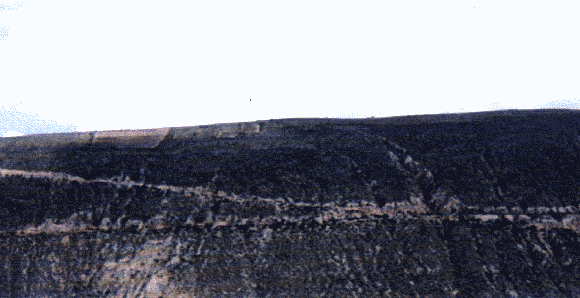 | |
|
Typical candidate rectenna site in the Andean highiands
Consequently, if rectennas are closer together than about 1200 kilometers each delivery period will be shortened. Consequently it would not be efficient to site two rectennas within mainland Ecuador. However, if considered desirable it would be possible to site a rectenna in the Galapagos as well as one on the mainland. Dr Collins also visited the equator near the small town of San Antonio. Although much of the terrain there is very rugged, there are barren areas on many hill-tops which could be used for a rectenna site, from which power could be delivered to neighbouring villages without electricity.
Issues arising
Siting a rectenna at high altitude in the Andes would have the advantage of providing information on operation of a rectenna in a cold climate. Most of the land around the equator is at low altitude so this would be usefully different from the experience of operating rectennas at low altitude sites. For the present, the issue of siting a rectenna in the Galapagos is considered politically sensitive, due to the attention being paid by UNESCO and other environmental organizations to the economic development of the islands. At a later date, if there is a will to do so, it should be easy, since a rectenna could provide electricity with minimal pollution. In addition conditions are very suitable for construction of a rectenna: there are good port facilities and roads, and electricity is already distributed through the island of San Cristobal by cables on posts beside the roads. The proposal by FUNDACYT that an SPS 2000 rectenna in Ecuador should be established as a corporation has many interesting implications. The legal ownership of SPS 2000 rectennas has not yet been considered in any detail, but ownership and operation by a company has the advantage of legal simplicity and 'transparency' - that is, it is easy for anyone to understand the project status since companies must publish accounts annually. It would also be simple for other organizations, including both domestic and foreign companies to participate. For companies interested in the potentially major new business of SPS in future, there are clearly benefits in participating in the first SPS pilot plant system. Thus the Ecuador rectenna may become an organizational model for other countries and for future commercial rectennas. A detailed report on this visit is available on request. The next visit will be to the Maldives during March 1997. | |
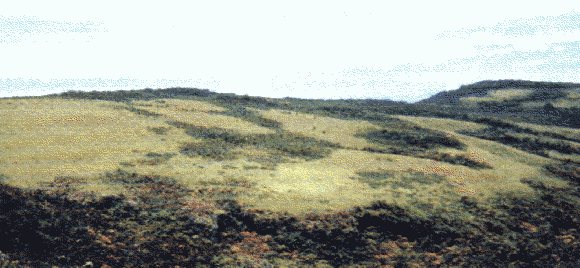 | |
|
Open land on San Cristobal island in the Galapagos archipelago
Launch Cost Prospects for SPS and SPS 2000
The feasibility of SPS becoming a major energy source for Earth in the future depends primarily on the cost. That is, it is almost certainly possible to build and operate solar power satellites, but whether they will or will not be used on a large scale will depend on whether the cost is competitive with other energy sources. And the major cost of all space activities today is the cost of launch. Using an expendable rocket, launch costs approximately $10,000! kg, or $10 million / ton to low Earth orbit (LEO). At such a cost solar power satellites weighing lOCOs of tons would obviously be impossibly expensive! Consequently from the earliest US studies of SPS in the 1970s it was understood that SPSs would have to be launched by reusable launch vehicles (RLVs) with low operating costs. Since that time the Space Shuttle has been developed by NASA and has entered operation - but it is only partly reusable, and it is unfortunately no cheaper than expendable launch vehicles. Consequently another generation of RLVs is needed to bring the cost of launch down to a level at which SPS could be economically competitive. Recently the subject of RLVs has started to receive increasing attention. For example, from 1993-1996 in the USA the DC-X and DC-XA projects demonstrated reusable operation of a Vertical Take-Off and Landing (VTOL) rocket vehicle. Although this vehicle performed only sub-sonic flight tests (far from the Mach 26 required to reach orbit!) it did demonstrate that reusable rocket vehicles can be operated efficiently, like aircraft, by a small team of people. And in 1996 the head of NASA, Mr Goldin said that US engineers should 'hang their heads in shame' because they have not developed a new rocket engine for 25 years, and has set a target of reducing the cost of launch by 90%. NASA is providing $900 million to develop the 'X-33' reusable rocket test-vehicle planned to reach Mach 15 during test flights in 1999. However, the budget for the X-33 project is only 2% of NASA's annual budget of $14,000 million, and it will last for only 3 years. After that Mr Goldin has said that private industry must develop the 'Venture Star' launch vehicle twice the size of X-33. NASA has no plans to develop an RLV. So we must recognise that reducing launch costs is still not a major priority for NASA - and nor is it for the other space agencies! We hope it will become a priority soon - and then SPS will get much more attention. As in several other matters, the situation of SPS 2000 is different from SPS. SPS 2000 is a pilot plant, to be used to demonstrate the operation of a real SPS. Consequently, though of course this must be done as cheaply as possible, it does not have to be cheaper than existing electricity sources in order to be worth building. It could even be launched using expendable rockets. At a cost of $ 10,000/kg, launching a 200 ton satellite like SPS 2000 would cost some $2000 million. This is several times more expensive than the satellite itself - but still only a fraction of annual government budgets for energy research. The cheapest expendable rocket to use would probably be the Russian 'Proton' rocket if it was launched from Alcantara in north-eastern Brazil - a possibility described in the magazine 'Aviation Week' (April 15, pp 22-23), and which was discussed during our field research visit to Brazil last year. Another possibility is that SPS 2000 payloads might be launched by a new RLV. In order to achieve reliability as high as aeroplanes, RLVs need to be flown hundreds of times - and so SPS 2000 could be a valuable customer since it will require tens of flights to launch 200 tons. Launch costs are so important for SPS (and for all space activities) that all good news for RLVs is good news for SPS and for SPS 2000.
SPS News
Successful WPT Demonstration in Reunion Island
As a follow-up to a workshop held on the island of Reunion in December 1995, the safe transmission of microwave power over a distance of lOOm was demonstrated on 26 November at Bois Court in Reunion. This was the first demonstration of WPT in Europe, and is a great step forward. Professor Kaya of Kobe University participated in the demonstration which was planned to prove the feasibility of using WPT for delivery of power to some houses at the bottom of a steep valley, Grand Bassin, to which delivery of electricity using ordinary cables is prohibitively expensive. For planning the rectennas to be used at Grand Bassin, Guy Pignolet had the excellent idea of inviting local architects and artists - not antenna engineers - to design the transmitting and receiving antenna. Of course they needed engineers' advice to achieve a feasible design, but artists are experts in eliciting 'public support' - which is what SPS needs most of all! They came up with a great design - quite different from the khaki-coloured dish antenna that might be expected from an engineering point of view. This project to design and implement an actual microwave power transmission-reception link for domestic power supply has been a great success so far. Initially conceived and guided by Guy Pignolet, it is now in its final stages managed by Dr Jean-Daniel Lan Sun Luk at the University of Reunion. It has not yet been finally decided to install a permanent WPT link, but such a decision would be most exciting - the first actual operational system in the world. We'll keep our fingers crossed!
SPS '97/WPT3
The 4th international SPS conference 'SPS '97' will be held in Montreal, Canada from August 24-28, in combination with 'WPT 3', the 3rd international conference on wireless power transmission. For information please contact the SPS '97 General Secretariat at: Canadian Astronautics & Space Institute, 8 18-130 Slater Street, Ottawa, Ontario, Canada; Fax no: (1) 613 234 9039.
Antenna business booming
The commercial antenna business in Japan is currently booming due to the popularity of portable telephones - 20 million have been bought in just 2 years. We hope that when the industry is booming like this there will be more support for other interesting antenna projects - like the largest transmitting antenna in the world, the huge 130m square SPS 2000 microwave-beam transmitting-antenna!
SPS 2000 at ISAS Open-Day
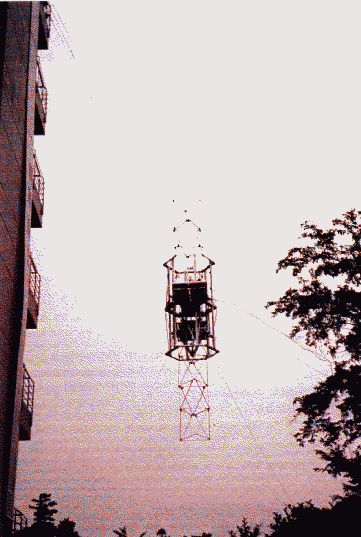 On August 3, the annual Open Day was held at the Institute for Space and Astronautical Science (ISAS) where the SPS 2000 project is directed. This year the main SPS 2000 exhibit was a 20 meter long segment of a 1/3 scale model of an SPS 2000 structural beam. This was assembled automatically by a solar-powered robot held in mid-air by cables from the top of one of the ISAS buildings (see photograph at right). One of the problems of such a large structure as the SPS 2000 satellite, which is to be 300 meters tall, is that it is difficult to simulate its 'zero-gravity' construction here on Earth. This is because the gravitational forces on even a relatively small structure such as that shown at right are very strong, requiring a much more massive structure than the actual SPS 2000 will be. This weighed some 200 kg - very heavy to lift! The real SPS 2000 will be built and will operate in weightless-ness in orbit, and will be much too weak to stand up on Earth. Computer-simulation and sub-scale experiments can be used to some extent, but a fully satisfactory solution to this problem has not yet been found.
Mini-Rectenna Corner
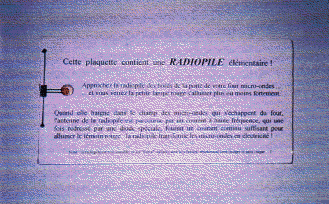 The photograph shows a 'mini-rectenna' made by Guy Pignolet at the Centre Nationale d'Etudes Spatiales (CNES) in France. Guy was a Visiting Researcher at the Nagatomo Laboratory at ISAS during the summer of 1994 when he built the first mini-rectenna with students at the Lab - a great invention! The mini-rectenna shown here comprises a single dipole connected to a diode and an LED. When held in front of the closed door of an operating microwave oven, the LED lights up - demonstrating wireless power transmission. The small amount of microwave power leaking through the door is absorbed by the dipoles, rectified by the diode and the DC current stimulates the LED. An advantage of this configuration is that it carries an explanatory text written on the side. Nice thinking! Mini-rectennas are an excellent, simple means of demonstrating microwave power transmission, and of explaining the concept of SPS. They are also very cheap to make! The diode costs 20 yen, the LED costs 100 yen, and the rest is just wire and plastic. We are happy to help SPS 2000 researchers to make their own mini-rectennas, by providing information and/or components. We will also be pleased to receive photographs, or even better, examples, of mini-rectennas made by readers in different countries! Regular Safety Note : Some people who see this demonstration say: 'Now I see that microwave ovens are dangerous - microwaves leak out of them!' However, this is incorrect. Microwaves do leak from ovens, but their intensity is governed by an international safety standard (see earler). Mini-rectennas can pick up microwave power at less than this intensity, and convert it to DC electric power. So, all ovens leak a small amount of energy within the safety limit - which is not dangerous and can be used - like the microwave energy that SPS 2000 will deliver!
Editorial - Near-Equatorial Countries' Collaboration
The SPS 2000 satellite will transmit a 10 MW microwave-beam to a number of sites within 3 degrees latitude of the equator. So far, 5 countries have agreed to participate in the project, and we hope to visit at least 5 more. However, researchers from several countries which are further than 3 degrees from the equator - China, India, Ghana, Bangladesh - have expressed interest in participating in SPS 2000 - since many many countries are concerned about future energy supplies. For example, Ghana extends north from 5 degrees north latitude to some 10 degrees north (longitude 3 degrees west to 1 degree east) and so its most southerly point, near the town of Takoradi, is about 200 kilometers too far north for an SPS 2000 rectenna. (Note that it is not too far north to receive microwave energy from a future SPS in a higher orbit.) Although it is not possible to site a rectenna further than 3 degrees from the equator, it would be possible to perform a number of experiments at such sites in order to study the microwave-beam transmitted from the SPS 2000 satellite. For example, measuring the cross-sectional distribution of microwave energy outside the main-beam and in the 'sidelobes', under both normal and abnormal atmospheric conditions - and also under different ionospheric and exo-atmospheric conditions such as during solar storms - would be valuable. Consequently we are planning a new category of collaboration for researchers in these countries, which we hope will be mutually beneficial. One of the basic guidelines of the SPS 2000 project is that it should lead on to other developments leading towards the realization of commercial SPS systems. One likely development will be that, because of the unique advantage that satellites at all altitudes in equatorial orbits have the same ground track every revolution, other solar power satellites will be launched into higher equatorial orbits, from which they will be able to deliver power to SPS 2000 rectennas for longer periods than the SPS 2000 satellite. Being at higher altitude these satellites will also be able to deliver power to rectennas further from the equator, so it is likely that there will be a second group of near-equatorial countries that will receive power from the 'second round' of power satellites. Consequently it will be valuable for researchers in these countries to get early experience in this field by participating in SPS 2000 in some way. Doing this will help to spread knowledge about SPS through the community of electrical, electronic, telecommunications and power engineers in each of these countries. It will also enable them to join the network of SPS 2000 countries where a growing body of knowledge about practical SPS engineering is being developed. In addition, all near-equatorial countries have an interest in SPS 2000 through their participation in the International Telecommunications Union (ITU). By existing international law a solar power satellite is a telecommunications satellite - because it transmits electromagnetic energy. This may sound strange since energy supply is a different industry from telecommunications. But in fact today's satellites are SPSs: they collect solar energy, generate electricity, and send microwave-beams to the Earth's surface - they're just 1 million times smaller than the ones we want to build! So SPS microwave power transmission is bound by international laws relating to telecommunications. Among other matters, these laws set limits for the amount of electromagnetic 'noise' that satellites are allowed to make at different frequencies. Most telecommunications systems use very low power densities, and even though the power density outside the main beam of the SPS 2000 satellite will be far below the level of 10 W/sqm in the centre of the beam, the signal may be picked up far outside the 'footprint' of the beam on the ground. Some terrestrial telecommunications systems may need filters to prevent them picking up energy at 2.45 GHz. A dialogue with near-equatorial as well as equatorial countries, and their collaboration in SPS 2000 will therefore be very helpful. Until the design of the SPS 2000 satellite transmitting antenna is completed, the detailed distribution of microwave energy in both the main beam and the side-lobes at 2.45 GHz, at higher harmonics (eg 2 x 2.45 4.9 GHz, 3 x 2.45 = 7.35 GHz, etc), and also outside the ISM band of 2.4-2.5 GHz, will not be known accurately. Once the design is finalised we will be able to decide how far from the equator it will be useful to make measurements - 5 degrees, 10 degrees or more. In the meantime we can also plan other forms of joint research which will be valuable for designing both the ground segment and the space segment of future SPS systems. So we look forward to working with colleagues from 'Near-Equatorial Countries' in planning a wide range of possible forms of international collaboration in the SPS 2000 pilot plant project. | |
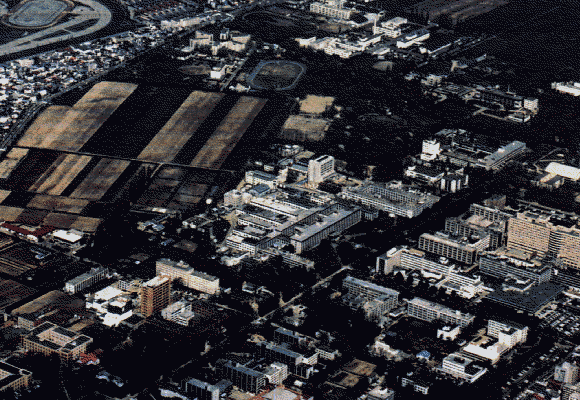 | |
|
The main Campus of Hokkaido University in the northern city of Sapporo, where research on the SPS 2000 microwave power transmission system is led by Professor Kiyohiko Itoh at the Laboratory of Electromagnetic Waves and Transmission in the Research Group of Information and Communication Electronics in the Division of Electronics Engineering of the Faculty of Engineering.
Glossary of terms used
Next issue, June 1997:
For correspondence, contributions or further information, please contact Patrick Collins at: Research Center for Advanced Science & Technology, University of Tokyo, 4-6-1 Komaba, Meguro-ku, Tokyo 153, Japan.
| |


